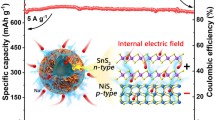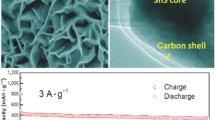Abstract
Metal sulfides are promising anode materials for sodium-ion batteries (SIBs) because of their high theoretical capacities. However, they are usually limited by their poor cycling performance and rate properties due to their large volume expansion and sluggish reaction kinetics. Herein, Sb2S3/SnS2/C heterostructures were fabricated by directly growing SnS2 nanoplates on Sb2S3 nanorods and then coating their surface with a carbon layer. Sodium-ion diffusion in several electrodes and different electrolytes was further evaluated to investigate the electrochemical performance of the heterostructures. Results revealed that the heterostructures greatly enhanced material stability and promoted ion and electron transport. Consequently, the Sb2S3/SnS2/C composites displayed a high reversible capacity of 642 mA h g−1 at a current density of 1 A g−1 after 600 cycles and a good rate performance of 367.3 mA h g−1 at 4 A g−1 in a NaPF6-diglyme electrolyte. Therefore, Sb2S3/SnS2/C heterostructures are promising anode materials for SIBs.
摘要
金属硫化物有着较高的理论容量, 是钠离子电池极具潜力的负极材料. 然而, 这类材料在电化学反应过程中存在体积膨胀和反应动力学缓慢的缺点, 使得其循环和倍率性能较差. 本文通过在Sb2S3 纳米棒上直接生长SnS2 纳米片并在其表面进一步包裹碳膜, 制备了Sb2S3/SnS2/C异质结构. 这种异质结构极大地提高了材料的稳定性, 并促进了离子和电子的运输. 研究结果表明, 在六氟磷酸钠/二乙二醇二甲醚电解质体系中充放电循环600次后, Sb2S3/SnS2/C复合电极材料在电流密度为1 A g−1时表现出642 mA h g−1的高可逆容量, 并且在4 A g−1时仍保留367.3mA h g−1的良好的倍率性能. 此外, 为了研究该材料的电化学性能, 本工作进一步探讨了钠离子在几种不同的电极材料和电解质中的扩散过程. 综上所述, Sb2S3/SnS2/C异质结材料有望成为一种拥有广阔应用前景的钠离子电池负极材料.
Similar content being viewed by others
References
Wang Y, Yang Q, Zhao Y, et al. Recent advances in electrode fabrication for flexible energy-storage devices. Adv Mater Technol, 2019, 4: 1900083
Wang G, He P, Fan LZ. Asymmetric polymer electrolyte constructed by metal-organic framework for solid-state, dendrite-free lithium metal battery. Adv Funct Mater, 2021, 31: 2007198
Lee J, Wang C, Malik R, et al. Determining the criticality of Li-excess for disordered-rocksalt Li-ion battery cathodes. Adv Energy Mater, 2021, 11: 2100204
Lin J, Zeng C, Lin X, et al. Metal-organic framework-derived hierarchical MnO/Co with oxygen vacancies toward elevated-temperature Li-ion battery. ACS Nano, 2021, 15: 4594–4607
Zuo W, Li R, Zhou C, et al. Battery-supercapacitor hybrid devices: Recent progress and future prospects. Adv Sci, 2017, 4: 1600539
Wang H, Zhu C, Chao D, et al. Nonaqueous hybrid lithium-ion and sodium-ion capacitors. Adv Mater, 2017, 29: 1702093
Choi C, Ashby DS, Butts DM, et al. Achieving high energy density and high power density with pseudocapacitive materials. Nat Rev Mater, 2020, 5: 5–19
Zhang L, Wei Q, Sun D, et al. Conversion reaction of vanadium sulfide electrode in the lithium-ion cell: Reversible or not reversible? Nano Energy, 2018, 51: 391–399
Wei Q, Jiang Y, Qian X, et al. Sodium ion capacitor using pseudocapacitive layered ferric vanadate nanosheets cathode. iScience, 2018, 6: 212–221
Xia X, Chao D, Zhang Y, et al. Generic synthesis of carbon nanotube branches on metal oxide arrays exhibiting stable high-rate and long-cycle sodium-ion storage. Small, 2016, 12: 3048–3058
Kim MS, Lim E, Kim S, et al. General synthesis of N-doped macroporous graphene-encapsulated mesoporous metal oxides and their application as new anode materials for sodium-ion hybrid supercapacitors. Adv Funct Mater, 2017, 27: 1603921
Kumaresan TK, Masilamani SA, Raman K, et al. High performance sodium-ion battery anode using biomass derived hard carbon with engineered defective sites. Electrochim Acta, 2021, 368: 137574
Liu M, Zhang J, Guo S, et al. Chemically presodiated hard carbon anodes with enhanced initial Coulombic efficiencies for high-energy sodium ion batteries. ACS Appl Mater Interfaces, 2020, 12: 17620–17627
Lao M, Zhang Y, Luo W, et al. Alloy-based anode materials toward advanced sodium-ion batteries. Adv Mater, 2017, 29: 1700622
Xiao Y, Lee SH, Sun YK. The application of metal sulfides in sodium ion batteries. Adv Energy Mater, 2016, 7: 1601329
Xie X, Su D, Chen S, et al. SnS2 nanoplatelet@graphene nanocomposites as high-capacity anode materials for sodium-ion batteries. Chem Asian J, 2014, 9: 1611–1617
Zhu Y, Nie P, Shen L, et al. High rate capability and superior cycle stability of a flower-like Sb2S3 anode for high-capacity sodium ion batteries. Nanoscale, 2015, 7: 3309–3315
Hou H, Jing M, Huang Z, et al. One-dimensional rod-like Sb2S3-based anode for high-performance sodium-ion batteries. ACS Appl Mater Interfaces, 2015, 7: 19362–19369
Ren Y, Wang J, Huang X, et al. Three-dimensional SnS2 flowers/carbon nanotubes network: Extraordinary rate capacity for sodium-ion battery. Mater Lett, 2017, 186: 57–61
Wang J, Luo C, Mao J, et al. Solid-state fabrication of SnS2/C nanospheres for high-performance sodium ion battery anode. ACS Appl Mater Interfaces, 2015, 7: 11476–11481
Cao L, Gao X, Zhang B, et al. Bimetallic sulfide Sb2S3@FeS2 hollow nanorods as high-performance anode materials for sodium-ion batteries. ACS Nano, 2020, 14: 3610–3620
Zhang Z, Zhao J, Xu M, et al. Facile synthesis of Sb2S3/MoS2 heterostructure as anode material for sodium-ion batteries. Nanotechnology, 2018, 29: 335401
Dong S, Li C, Ge X, et al. ZnS-Sb2S3@C core-double shell polyhedron structure derived from metal-organic framework as anodes for high performance sodium ion batteries. ACS Nano, 2017, 11: 6474–6482
Zhang J, Wang DW, Lv W, et al. Achieving superb sodium storage performance on carbon anodes through an ether-derived solid electrolyte interphase. Energy Environ Sci, 2017, 10: 370–376
Wu J, Liu J, Cui J, et al. Dual-phase MoS2 as a high-performance sodium-ion battery anode. J Mater Chem A, 2020, 8: 2114–2122
Wan Y, Song K, Chen W, et al. Ultra-high initial Coulombic efficiency induced by interface engineering enables rapid, stable sodium storage. Angew Chem Int Ed, 2021, 60: 11481–11486
Zhang M, Li Y, Wu F, et al. Boosting the ultrahigh initial coulombic efficiency of porous carbon anodes for sodium-ion batteries via in situ fabrication of a passivation interface. J Mater Chem A, 2021, 9: 10780–10788
Sahoo RK, Singh S, Yun JM, et al. Sb2S3 nanoparticles anchored or encapsulated by the sulfur-doped carbon sheet for high-performance supercapacitors. ACS Appl Mater Interfaces, 2019, 11: 33966–33977
Wang M, Fan L, Wu X, et al. SnS2/SnO2 heterostructures towards enhanced electrochemical performance of lithium-sulfur batteries. Chem Eur J, 2019, 25: 5416–5421
Ge P, Zhang L, Zhao W, et al. Interfacial bonding of metal-sulfides with double carbon for improving reversibility of advanced alkali-ion batteries. Adv Funct Mater, 2020, 30: 1910599
Sun XM, Chen X, Deng ZX, et al. A CTAB-assisted hydrothermal orientation growth of ZnO nanorods. Mater Chem Phys, 2002, 78: 99–104
Liang H, Ni J, Li L. Bio-inspired engineering of Bi2S3-PPy yolk-shell composite for highly durable lithium and sodium storage. Nano Energy, 2017, 33: 213–220
Wang S, Liu S, Li X, et al. SnS2/Sb2S3 heterostructures anchored on reduced graphene oxide nanosheets with superior rate capability for sodium-ion batteries. Chem Eur J, 2018, 24: 3873–3881
Cheng XB, Zhao MQ, Chen C, et al. Nanodiamonds suppress the growth of lithium dendrites. Nat Commun, 2017, 8: 336
Polino G, Scaramella A, Manca V, et al. Nanodiamond-based separators for supercapacitors realized on paper substrates. Energy Technol, 2020, 8: 1901233
Song Y, Li H, Wang L, et al. Nanodiamonds: A critical component of anodes for high performance lithium-ion batteries. Chem Commun, 2016, 52: 10497–10500
Postnov VN, Mel’nikova NA, Shul’meister GA, et al. Nafion- and aquivion-based nanocomposites containing detonation nanodiamonds. Russ J Gen Chem, 2017, 87: 2754–2755
Jia R, Du H, Zhang X, et al. Stretchable and compressible supercapacitor with polyaniline on hydrogel electrolyte. J Electrochem Soc, 2018, 165: A3792–A3798
Su D, Kretschmer K, Wang G. Improved electrochemical performance of Na-ion batteries in ether-based electrolytes: A case study of ZnS nanospheres. Adv Energy Mater, 2016, 6: 1501785
Li D, Chen L, Wang T, et al. 3D fiber-network-reinforced bicontinuous composite solid electrolyte for dendrite-free lithium metal batteries. ACS Appl Mater Interfaces, 2018, 10: 7069–7078
Wu C, Wu ZG, Zhang X, et al. Insight into the origin of capacity fluctuation of Na2Ti6O13 anode in sodium ion batteries. ACS Appl Mater Interfaces, 2017, 9: 43596–43602
Park JY, Kim SJ, Yim K, et al. Pulverization-tolerance and capacity recovery of copper sulfide for high-performance sodium storage. Adv Sci, 2019, 6: 1900264
Jiao Y, Mukhopadhyay A, Ma Y, et al. Ion transport nanotube assembled with vertically aligned metallic MoS2 for high rate lithium-ion batteries. Adv Energy Mater, 2018, 8: 1702779
Xue H, Yu DYW, Qing J, et al. Pyrite FeS2 microspheres wrapped by reduced graphene oxide as high-performance lithium-ion battery anodes. J Mater Chem A, 2015, 3: 7945–7949
Pan L, Zhu XD, Xie XM, et al. Smart hybridization of TiO2 nanorods and Fe3O4 nanoparticles with pristine graphene nanosheets: Hierarchically nanoengineered ternary heterostructures for high-rate lithium storage. Adv Funct Mater, 2015, 25: 3341–3350
Han W, Qin X, Wu J, et al. Electrosprayed porous Fe3O4/carbon microspheres as anode materials for high-performance lithium-ion batteries. Nano Res, 2018, 11: 892–904
Zhang Y, Zhu P, Huang L, et al. Few-layered SnS2 on few-layered reduced graphene oxide as Na-ion battery anode with ultralong cycle life and superior rate capability. Adv Funct Mater, 2015, 25: 481–489
Fan L, Li X, Song X, et al. Promising dual-doped graphene aerogel/SnS2 nanocrystal building high performance sodium ion batteries. ACS Appl Mater Interfaces, 2018, 10: 2637–2648
Yu DYW, Prikhodchenko PV, Mason CW, et al. High-capacity antimony sulphide nanoparticle-decorated graphene composite as anode for sodium-ion batteries. Nat Commun, 2013, 4: 2922
Thangavel R, Pandian AS, Ramasamy HV, et al. Rapidly synthesized, few-layered pseudocapacitive SnS2 anode for high-power sodium ion batteries. ACS Appl Mater Interfaces, 2017, 9: 40187–40196
Lee M, Hong J, Lopez J, et al. High-performance sodium-organic battery by realizing four-sodium storage in disodium rhodizonate. Nat Energy, 2017, 2: 861–868
Liu Q, Deng W, Sun CF. A potassium-tellurium battery. Energy Storage Mater, 2020, 28: 10–16
Wang J, Polleux J, Lim J, et al. Pseudocapacitive contributions to electrochemical energy storage in TiO2 (anatase) nanoparticles. J Phys Chem C, 2007, 111: 14925–14931
Cai P, Zou K, Zou G, et al. Quinone/ester-based oxygen functional group-incorporated full carbon Li-ion capacitor for enhanced performance. Nanoscale, 2020, 12: 3677–3685
Chen M, Hua W, Xiao J, et al. Development and investigation of a NASICON-type high-voltage cathode material for high-power sodiumion batteries. Angew Chem, 2020, 132: 2470–2477
Dong X, Chen L, Su X, et al. Flexible aqueous lithium-ion battery with high safety and large volumetric energy density. Angew Chem Int Ed, 2016, 55: 7474–7477
Acknowledgements
This work was supported by the National Natural Science Foundation of China (51972025).
Author information
Authors and Affiliations
Contributions
Author contributions The paper was written through the contributions of all authors. All authors have given approval to the final version of the paper.
Corresponding authors
Ethics declarations
Conflict of interest The authors declare that they have no conflict of interest.
Additional information
Supplementary information Supporting data are available in the online version of this paper.
Rui Jia received her BE degree in 2015 from Huaqiao University and ME degree in 2018 from Qingdao University. She is a PhD candidate at the college of Mathematics and Physics, University of Science and Technology Beijing. Her research interests mainly focus on SIBs and hybrid supercapacitors.
Guozhen Shen received his BSc degree (1999) in chemistry from Anhui Normal University and PhD degree (2003) in chemistry from the University of Science and Technology of China. He joined the Institute of Semiconductors, Chinese Academy of Sciences as a professor in 2013. His current research focuses on flexible electronics and printable electronics, including transistors, photodetectors, sensors, and flexible energy storage and conversion devices.
Di Chen received her BSc degree (1999) in chemistry from Anhui Normal University and PhD degree (2005) in chemistry from the University of Science and Technology of China. She joined the University of Science and Technology Beijing as a professor in 2014. Her current research focuses on energy storage materials and devices.
Rights and permissions
About this article
Cite this article
Jia, R., Li, L., Shen, G. et al. Hierarchical Sb2S3/SnS2/C heterostructure with improved performance for sodium-ion batteries. Sci. China Mater. 65, 1443–1452 (2022). https://doi.org/10.1007/s40843-021-1931-0
Received:
Accepted:
Published:
Issue Date:
DOI: https://doi.org/10.1007/s40843-021-1931-0




